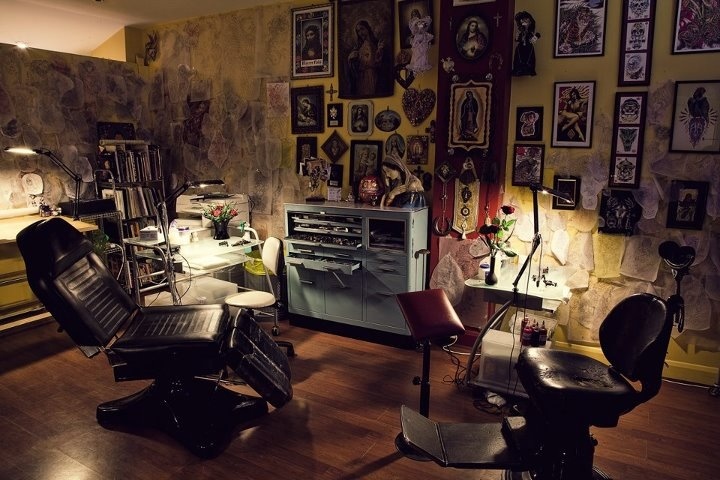- Москва, ул.Лётчика Грицевца 14а,
м. «Пыхтино» - Ежедневно, с 1200 до 2000
- +7 (915) 000-77-99 - (Телефон салона) +7 (915) 000−77−99 - (WhatsApp)+7 (915) 000−77−99 - (Viber)
- domtattoo@yandex.ru
CONCLUSION
Все о татуировках
- Стили татуировки
- Белая татуировка
- Биомеханика (Biomechanics) и Органика
- Блэкворк ( Blackwork)
- Дотворк (Dotwork)
- Готика «Gothic»
- Кельтские
- Клокворк
- Нью Скул ( New School)
- Олд Скул ( Old School)
- Ориентал (Oriental)
- Полинезия
- Реализм
- Стимпанк
- Сюрреализм (Сверхреализм)
- Трайбл (Tribal)
- Треш полька
- Черно-серая "Black&grey"
- Чикано (Chicano)
- Этнический стиль тату (Ethnic)
- Японские тату
- Тотемные тату Тлинкитов
- Татуировки- надписи
- Временная татуировка.
- Хоррор
- Парные тату
- Крестиком
- Кружева
- Ультрафиолетовая татуировка
- Татуировки на частях тела
- Надписи для тату с переводом
- Надписи с переводом с немецкого на русский язык
- Надписи, афоризмы, цитаты на португальском и бразильском языке с переводом на русский
- Надписи на испанском с переводом
- Перевод фраз и гимнов (стихов) с хинди на русский
- Фразы, надписи и афоризмы на арабском языке с переводом
- Надписи для мужчин
- Надписи для девушек
- Вопросы о татуировках
- Астрология и астральная геометрия
- Значение тату
- Уход за татуировкой
- Для СМИ и видео проектов
- Татуировка на шрамах
- Иглы и краски для татуировок
- Зодиакальные татуировки...
- Стили, виды татуировки. Сведение тату.
- English language
- Все о Сак Янт - Тайской Шаманской Татуировки
- Священные татуировки - ИЗ ПРОШЛОГО
- МАГИЧЕСКИЕ ЧЕРНИЛА: ЗАКЛИНАНИЯ И СИГИЛЫ
- ИГЛОЙ НА КОЖЕ
- ЛУК СИТ
- КХРУ САК
- ВИЧА
- ТЕКСТЫ И ЧИСЛА, ТЕЛЕСНЫЙ ЩИТ
- ЯНТРЫ ЧОК ЛАП ПРИНОСЯТ УДАЧУ И ПРОЦВЕТАНИЕ.
- ТРАНС
- ТРАДИЦИИ САК ЯНТ В ТАИЛАНДЕ
- ЗАКЛИНАНИЯ И ПИСЬМЕНА
- Обучение мастеров-татуировки в Тайланде (ТРАНСФОРМАЦИЯ И ДИСЦИПЛИНА)
- Сигилизм
Информация
- Портфолио
- Все о пирсинге
- Виды и стили
- Подготовка и процедура пирсинга
- Когда пирсинг уже сделан
- Бод Мод
- Украшение для пирсинга
- Инструмент для пирсинга
- Словарь терминов
- Cтоимость пирсинга
- Магическое, символическое значение пирсинга
- Вопросы и ответы про пирсинг
- Удаление татуировок
- Все о татуаже
- Новости
- Ответы на часто задаваемые вопросы о тату.
- Работы тату художника Yann Travaille
- Съемки MTV
- Проба пера
- Съемки Дискавери в судии ...
- Энциклопедия пирсинга
- 7 Московская Международная Тату Конвенция
- «Звёздный» гость салона «Дом Элит Тату» - известный продюсер Андрей Клюкин
- Ушел из жизни тату мастер Илья Смирнов
- Мы примим участие в Питерской тату конвенции 2015 года
- У нас делают татуировки модели Creepy Sweets
- Оригинальный майки и футболки с аэрографией за 4.000 рублей
- Мы получили независимую премию "Лучший Тату Салон 2015 года" по версии портала Татуировка.Рф
- Мы участники и победители тату конвенции в Москве
- Мы организаторы "Ночи Татуировщика 2015 в Москве"
- Rock heroes: Miss Тату Хабаровск
- Немецкий политик сядет в тюрьму за то что сделал нацистскую татуировку
- Международная Московская Тату Конвенция 2016
- Санкт-Петербургский Тату-Фестиваль
- 2 Международный фестиваль татуировки Сочи 2016
- Самый старый татуированный человек на нашей планете.
- 9-я Международная Московская Тату Конвенция 2017
- Тату мастер с 1.4 миллионом подписчиков маскирует растяжки
- Miss Tattoo Australia Дженн Десмонд - водитель грузовика
- Тату разрешены
- Зейн Малик сделал татуировку с глазами Джиджи Хадид на груди
- Тату как запрет на реанимацию
- В честь ЛДПР прошла тату-вечеринка
- Тату салон в Самаре
- Аренда места в тату салоне Москва. Как правильно и главное где арендава
- Обучение и все о нем
The tattooist is. on the one hand. a commercial artist. a worker involved in
exercising (ideally) a unique skill while creating (again. ideally) for profit
a product that contains elements
 While examining the work and experience
of the tattooist helps to enlarge our general understanding of commercial art
activities and service work. the unique features of tattooing imbue it with a
special sociological interest. Tattooing is. in Hughes's (l971c) term. a
«bastard institution» supplying what is still
While examining the work and experience
of the tattooist helps to enlarge our general understanding of commercial art
activities and service work. the unique features of tattooing imbue it with a
special sociological interest. Tattooing is. in Hughes's (l971c) term. a
«bastard institution» supplying what is still
This change in the cultural and organizational context has been paralleled
by significant alterations in the careers and occupational experience of
tattooists. An enlarged and diversified client pool has increased tattooists'
occupational opportunities and enhanced their financial security. As tattooing
has begun to enjoy a modest level of legitimacy within the larger art world.
tattooists' positive
The previous chapter examined the tattoo experience of the consumer while
this discussion has focused on the career and occupational experience of the
tattoo practioner. We turn now to enter the tattoo studio. the immediate
interactional setting in which the major actors meet and the tattoo encounter
takes place. It is here that the tattooist employs his or her acquired social
skills. places customers into definitional categories. and attempts to exercise
control over the commercial and creative exchange. In turn. the tattooee
attempts to communicate his or her desires and construct an understanding of
the unfamiliar and often
.jpg)





